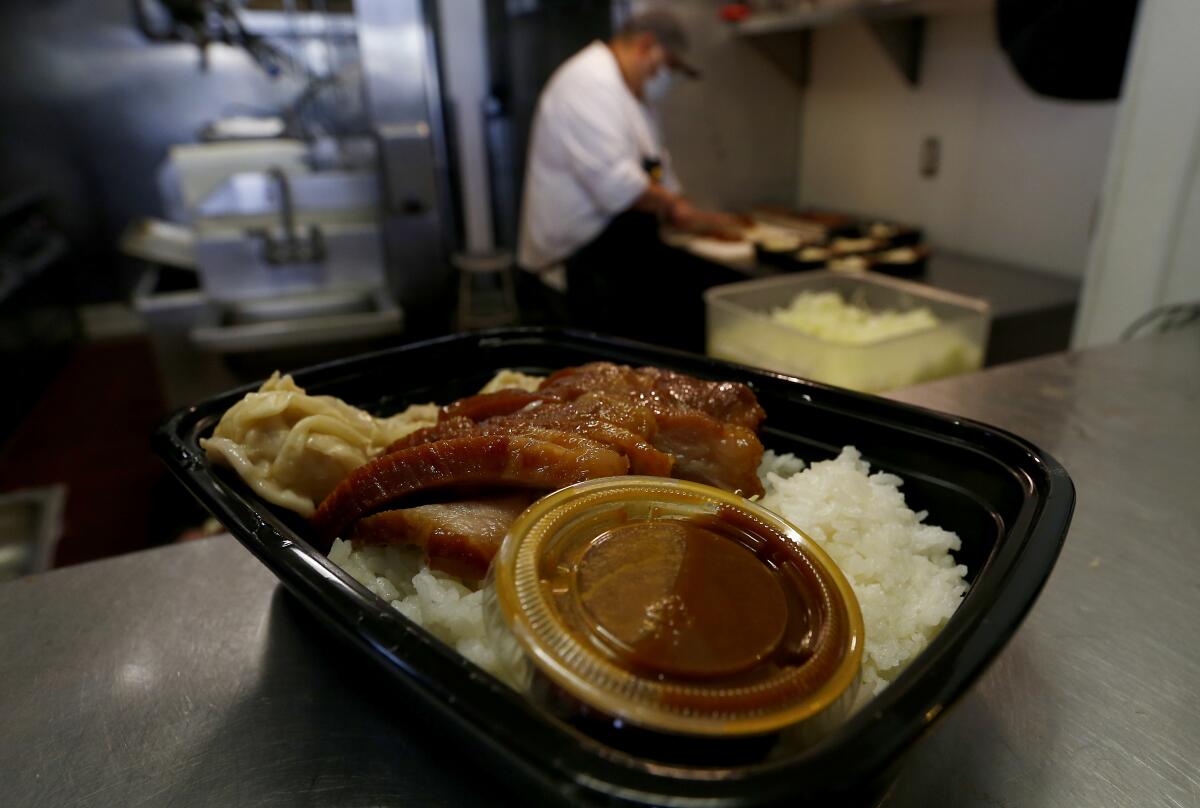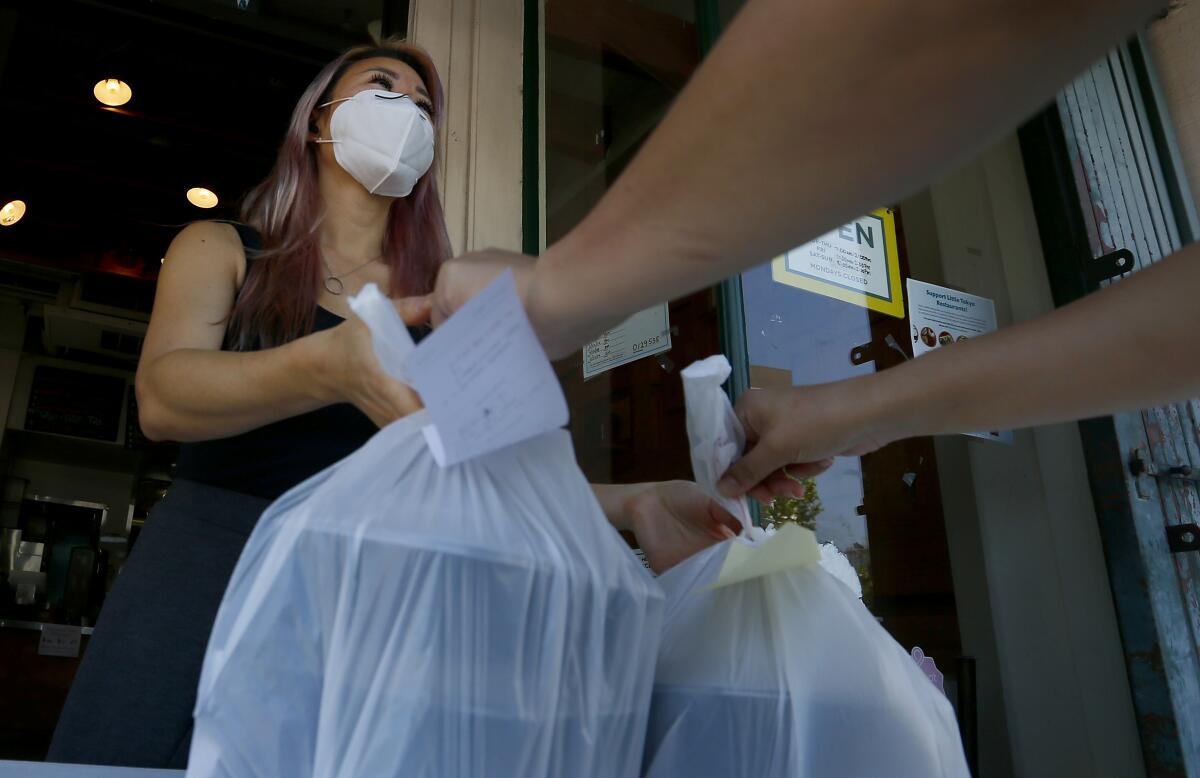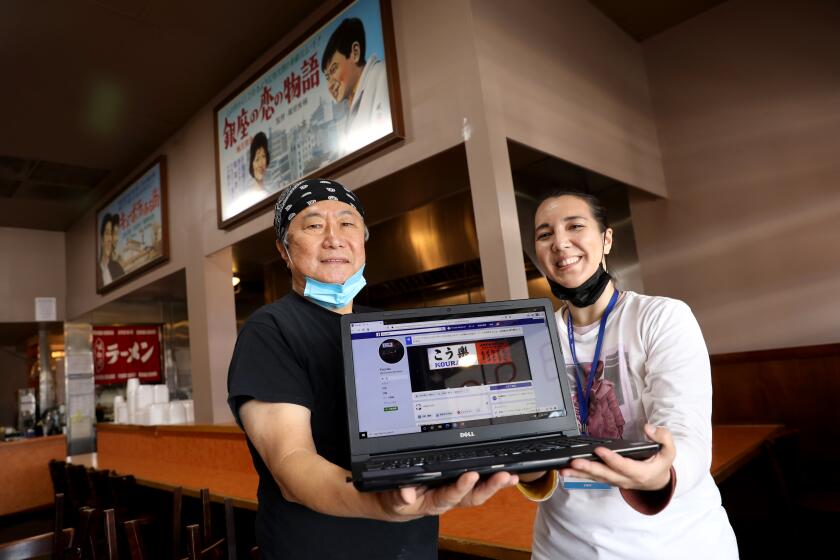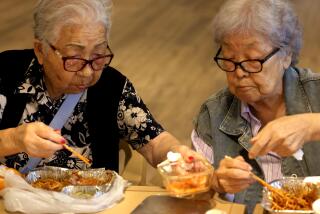‘The fight is always somewhere in us’: Asian American history and a Little Tokyo combo meal

- Share via
The chashu shumai combo from Tokyo Gardens holds a place of honor among the taste memories of Japanese Americans in Los Angeles, a fabled casualty of Little Tokyo’s evolution over the years.
It’s a generous serving of caramelized chashu pork paired with four shumai, rice and pickles that has not been served since 2013, when Glen Ishii’s grandma hung up her apron to make way for Ishii’s restaurant, Jist Cafe.
Then the pandemic struck. Business fell by more than 50%, Ishii said. So last month, the former executive chef of the restaurant at the Omni Hotel decided to try something new that was also something very old: his grandmother’s recipe.
Hundreds of orders of the beloved combo meal sold out in less than half an hour. The taste sparked remembrances from nostalgic diners all over the Southland. And for a few moments, a community accustomed to mourning the steady disappearance of its cultural touchstones instead got to taste the return of something once thought lost.
“Before we started doing this, to be honest, it was really kind of depressing. Starting this has really rejuvenated everybody at the restaurant,” Ishii said.

The chashu shumai combo has been a much-needed bright spot in this pandemic. It’s also the best illustration of a community ethic that has rallied a small army of volunteers and social service organizations to Little Tokyo’s aid.
Put simply, history matters, said Kristin Fukushima, managing director of the Little Tokyo Community Council.
Valuing history means that restaurants are not just businesses but invaluable capsules of untold histories and human experience. That seniors are not just vulnerable and in need of help, but also the keepers of the community’s stories and the teachers of history’s lessons. It means that every inch of 1st Street real estate is precious and worth fighting for, because you remember when this country took it away, and how much your ancestors sacrificed to get it back.
Many Little Tokyo restaurants have operated for decades without much online presence. The pandemic has changed that, and Mariko Lochridge from the Little Tokyo Service Center is trying to bring them up to speed.
So, when quarantine conditions were ordered, a veritable squadron of community groups including the Little Tokyo Service Center and the Little Tokyo Community Council descended on the neighborhood. They immediately organized donation programs that paid restaurants to provide free meals to homebound seniors, frontline workers and those who’ve lost money or jobs to the quarantine, a strategy that last month became an official state program.
When emergency information and aid information was disseminated only in English and Spanish, volunteers translated it into Japanese as well as Korean, reflecting the area’s changing demographics. Every week, volunteers take turns delivering meals, spreading information and fulfilling requests.
“We rely on each other. We show up for each other. And we were like this before the crisis,” Fukushima said.
Little Tokyo has always stood out among this city’s ethnic enclaves for the value it places on history. The Japanese American National Museum is the largest museum of its kind in the nation. Curator Karen Ishizuka says the focus of its latest exhibit is not just about preserving history, but showing how its lessons are relevant to the present.
“We’re trying to use the past to serve the present,” said Ishizuka, who has also written a book about the Asian American movement in Los Angeles in the 1960s, the era of student activism during which the term “Asian American” was coined.

Part of this focus on history is because Japanese Americans have a history they cannot forget. Mass incarceration — and the traumatic reminder that American citizenship and belonging can be summarily revoked — leaves an indelible mark. And I’ve been thinking a lot about history and its role lately, and not just because May is Asian Pacific American Heritage Month.
Asian Americans are facing a historic wave of racism fueled by nationalism and pandemic fear. A tracker by A3PCON and Chinese Americans for Affirmative Action recorded 1,497 incidents in its first month, with more than 8% of reports involving physical violence. More than 30% of Americans have witnessed someone blaming Asian people for the pandemic, according to a survey from the Center of Public Integrity.
All this is happening as Asian Americans, disproportionately represented in the medical field, are hit especially hard by COVID-19. In the New York-New Jersey area, where one out of every four Filipino Americans is employed in the healthcare industry, at least 30 Filipino healthcare workers have died of complications from COVID-19, according to a ProPublica investigation.
We have responded to this historic moment in many admirable ways. Many Asian American elected officials have forcefully and consistently condemned the casual association of virus danger with Chinese identity, called upon the FBI to investigate the violence and pushed for more resources to battle hate crimes. Asian American volunteers and organizations have been instrumental in equipping unprepared hospitals with protective equipment. This month, the Asian Pacific Community Fund is launching a campaign to raise money for the organizations that have served as unofficial life support for ethnic enclaves.
But I’ve also seen responses from Asian Americans that fill me with despair. We have calls, again, to fight racism by proving our American-ness. In an op-ed, former presidential candidate Andrew Yang cited the sacrifices of the Japanese American 442nd Infantry Regiment during World War II as an example of patriotism but failed to state that the reward for that patriotism was mass incarceration.

And the other day I saw a post advertising T-shirts for sale with the slogan “I’m Asian but not Chinese.” During the L.A. uprisings of 1992, T-shirts were signs taped to the doors of Asian businesses that said “I’m not Korean.” Those businesses burned anyway. During the mass incarceration, these signs were buttons worn by Chinese Americans that said “I’m not Japanese.”
The feeling of déjà vu is unavoidable. Here we are again, trusting in the poisoned promise that our prosperity will protect us. It seems we have forgotten the lesson that no amount of T-shirts, signs, buttons or patriotism has ever kept anyone safe from racism in the long run.
But Little Tokyo remembers. And Historic Filipinotown remembers. Chinatown, Thai Town and pretty much every other ethnic enclave in Los Angeles contain the memory of a time when the threat of racism forced us into the same neighborhoods and reminded us that we needed one another.
I think that time is here again. If you are an Asian American who can be mistaken for Chinese, you can feel the eyes on you at the grocery store or on your daily walk. If you haven’t witnessed or experienced this yourself, you know another Asian American who has. On your feeds, you can sense the political discourse shifting against people who look like you. As the consequences of this virus deepen, and as our president continues to single out minorities and blame China for America’s disastrous response to the virus, I’m worried that things will only get worse.
It’s more important than ever for us to understand and accept our history. And PBS is making it easy: Next week it is releasing a five-hour film series on the histories of Asian Americans. Not everyone took Asian American studies in college or has time to become a race scholar. But if we look for answers in our past, we can find hope for our future, as Glen Ishii did.
A good place to start is understanding that ethnic enclaves are not just good places to eat. In each of these neighborhoods, there is a historic fight for rights and equality that has never ended. It’s a fight in which many of us have declared victory and then withdrawn. But others have continued it, like Traci Kato-Kiriyama, an artist and organizer in Little Tokyo who co-founded the Tuesday Night Project, the longest-running Asian American mic series in the United States.
After mass incarceration, Japanese Americans took up the fight for redress and reparations, Kato-Kiriyama said. Then they fought to rebuild Little Tokyo, fended off the city’s proposal to build a 510-bed jail in the historic community and weathered intense gentrification.
And when Muslim Americans were targeted after 9/11, or when this current administration placed immigrants in cages at the border, many Japanese American activists took up that fight too, because they understand that the fight against racism is much larger than just the Asian American community.
“We’ve always had to fight to know where we come from. We’ve always had to fight to be who we want to be, for existence, for community,” Kato-Kiriyama said. “The fight is always somewhere in us.”
More to Read
Sign up for Essential California
The most important California stories and recommendations in your inbox every morning.
You may occasionally receive promotional content from the Los Angeles Times.















